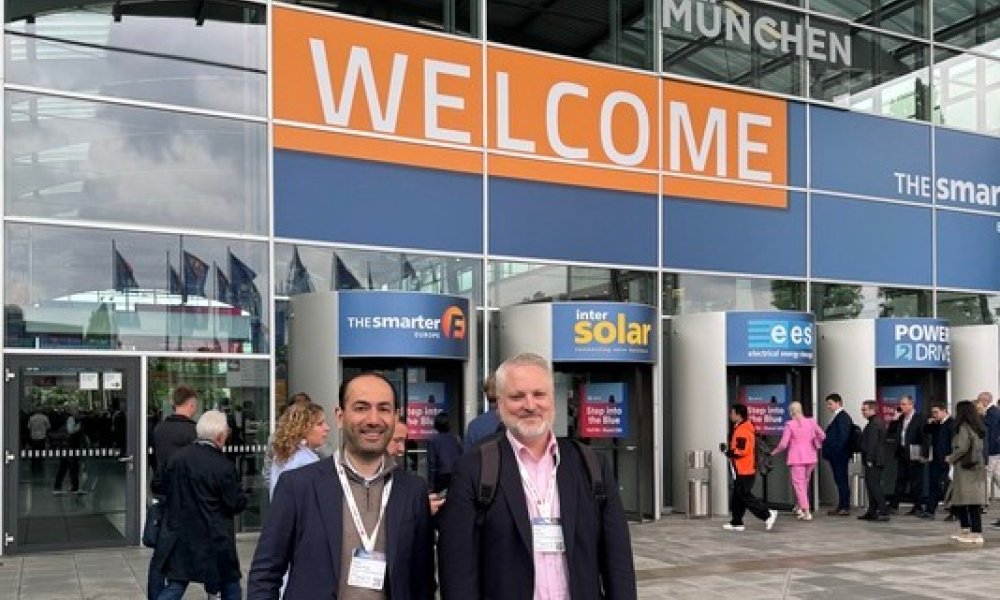If you're keen on the global solar sector, the Intersolar Europe event in Munich is a must-visit. It offers comprehensive insights into markets, technologies, and financing for photovoltaic (PV) projects. Attendees include project developers and planners, Engineering, Procurement, and Construction (EPC) contractors, installers and system integrators, manufacturers and suppliers, distributors, energy consultants, energy utilities, investors and analysts, as well as architects and energy planners.
We attended this year’s conference, spending a full day and a half exploring the event and attending meetings, to gain a deeper understanding of the solar and broader renewable energy sectors.
A sector constantly in flux
The solar industry, often dubbed the "solar coaster," is well-acquainted with market turbulence. Despite robust global growth exceeding many industry forecasts over the years, the sector's stock market performance has been notably volatile, swinging widely between optimism and despair. Recently, factors such as inflation, higher interest rates, policy uncertainty, and oversupply have led many investors to lose confidence in the sector.
Anecdotally, some attendees at this year’s edition of Intersolar Europe mentioned that the event used to attract more visitors and even featured performances by global artists, reflecting the optimism that once surrounded the sector. While we haven't confirmed this information, it might suggest a sentiment that things were better in the past. Additionally, if large exhibition stands are any indication of dominance, Chinese companies certainly stood out.
What we learned at this year’s event
From our meetings, several key insights emerged. Firstly, the development of renewables varies significantly by region. In Europe, utility-scale renewables (wind and solar) are progressing robustly, while residential solar is still in recovery mode. In the US, uncertainty remains high due to the pending clarification around the Inflation Reduction Act (IRA).
In countries with high renewable energy penetration like Germany and Spain, discussions have centred on grid balancing solutions, especially after the recent blackout in the Iberian Peninsula, the cause of which remains unknown. While Battery Energy Storage Solutions (BESS) are improving and becoming more affordable, feedback from our meetings highlighted the need for more education from grid operators to governments and the public.
In terms of technology, major manufacturers are currently focusing on Tunnel Oxide Passivated Contact (TOPCon) and Heterojunction Technology (HJT). Other technologies, such as Perovskite, face stability issues. Although Perovskite modules have good efficiency, they struggle with material instability and higher costs, making them uncompetitive.
Additionally, degradation remains a significant problem. Perovskite + glass cells show promise but need a few more years to become competitive. Interdigitated Back Contact (IBC) cells offer only slight efficiency improvements compared to TOPCon, so manufacturers prefer to stick with TOPCon and HJT for now.
Global market outlook
We had the opportunity to meet with SolarPower Europe and discuss the key takeaways from their recently released Global Market Outlook for Solar Power 2025–2029 and European Market Outlook for Battery Storage 2025–2029 during the conference. Here are the main points:
Solar Power
- Global PV Installations: Reached 597 GW DC, growing by 33%. Although this is a slowdown from the previous year's 85% growth, it remains a strong development.
- Solar accounted for 81% of all renewable capacity added worldwide while its share of overall electricity generation rose to 7%, nearly doubling in three years.
- China's Dominance: With 329 GW installed, China holds the largest share, more than double the capacity of all other top 10 solar markets combined.
- The solar industry is still facing an oversupply situation, with production capacities reaching roughly twice the current level of demand for polysilicon, wafers, cells, and modules. As a result, the price of solar modules further decreased in 2024.
- Cumulative Installations: Totalled 2.2 TW last year, with China holding 44%, the EU 18% (down from 20% in 2023), and the Americas 16%. The solar fleet doubled from 1 TW to 2 TW in just two years while it took 70 years to reach the first terawatt.
- Future Projections: SolarPower Europe expects market growth to soften in 2025, with installations projected at 548 GW (low case), 655 GW (base case), and 774 GW (high case), representing -8%, +10%, and +30% year-over-year growth, respectively. This is due to rising curtailment and grid challenges in more advanced markets.
- Chinese Market Slowdown: Expected in 2025 and 2026 due to policy changes which raise uncertainty for projects connected to the grid after June 1, 2025, transitioning from Feed-in Tariff (FiT) to a market-based pricing system.
- Post-2026 Growth: After a stagnant 2026, installations will grow again, reaching 10-14% from 2027-2029 and potentially surpassing 1 TW by 2029 in the high scenario.
- EU-27 Market: Anticipated to remain largely flat at 65.8 GW (+0.7%). By 2029, global annual PV installations are expected to reach 930 GW.
- Solar PV is projected to account for 65% of the renewable capacity needed to meet the COP28 Dubai goal to triple renewable energy capacity to 11 TW by 2030.
Battery Energy Storage Systems (BESS)
- EU Installations: Reached 21.9 GWh in FY24, totalling 61.1 GWh. Germany, Italy, and the UK account for 70% of the market. The annual growth rate slowed down to 15% after three consecutive years of doubling newly added capacity.
- Future Growth: Annual BESS installations are expected to grow by 36% year-over-year to 29.7 GWh in 2025 in the medium scenario, reaching 118 GWh by 2029. This would represent a size five times larger than 2024.
- Sector Trends: The residential sector is slowing down, while the utility sector is expected to drive growth.
- EU Targets: No specific targets for BESS installations have been set. Simplifying grid connections could unleash installation potential.
About Intersolar Europe
Intersolar Europe is part of “The smarter E Europe”, Europe’s Largest Alliance of Exhibitions for the Energy Industry. This alliance includes four major events: Intersolar Europe, ees Europe, Power2Drive Europe, and EM-Power Europe. The smarter E Europe focuses on integrated energy solutions and attracts over 2,737 exhibitors and more than 100,000 visitors.




